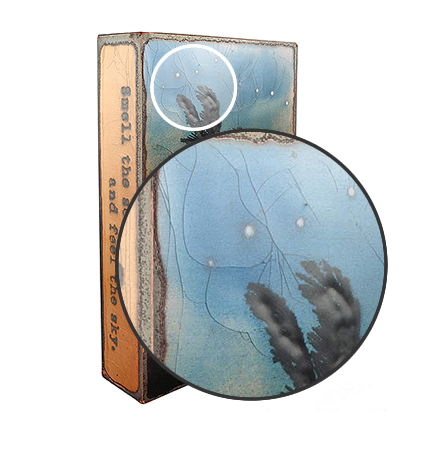Understanding Houston Llew’s Crazing Technique: The Beauty Behind the “Cracks”
If you’ve noticed fine, hairline cracks or lines across the surface of your Houston Llew Spiritile, you might wonder whether something is wrong. In fact, those delicate lines - called crazing are an intentional and beautiful part of the enameling process that makes each Spiritile a one-of-a-kind work of art.
What Is Crazing?
Crazing refers to the fine network of lines that can appear on the surface of glass enamel after firing. These lines are not cracks in the metal or enamel, but a natural visual effect that happens when the molten glass cools and contracts at a slightly different rate than the copper it’s fused to.
In traditional vitreous enamel work - the same centuries-old process used on jewelry, clocks, and architectural art — this effect is sometimes embraced as part of the medium's character. Houston Llew takes this one step further by refining the process so that every Spiritile’s surface tells a subtle story of heat, time, and transformation.

A Signature Element of Houston Llew’s Artistry
Each Spiritile is hand-crafted in Charleston, North Carolina using powdered glass, copper panels, and precise kiln firing. During firing, the glass reaches over 1,500°F before cooling — and it’s in that cooling phase that the crazing emerges.
Also during the cooling phase, a pin is rolled over the copper & glass panel. This process creates more crazing and also makes the panel more malleable so it can wrap around the solid block of wood that serves as a body for the vitreous enamel art piece.
Rather than being a flaw, Houston Llew views crazing as asignature of authenticity— proof that every Spiritile has been individually fired, hand-finished, and fused by human hands. Just as brushstrokes are unique to a painting, no two Spiritiles will ever “craze” in exactly the same way.
Why Some Spiritiles Show More Crazing Than Others
Because each design uses different pigments, glass compositions, and layers of enamel, some Spiritiles develop a more visible crazing pattern than others. Lighter colors and larger solid areas often reveal the effect more clearly. Over time, these faint lines may even shift subtly, deepening the sense of depth and texture that collectors love.
Crazing does not affect the integrity or longevity of your Spiritile. The glass enamel remains securely fused to the copper surface. Your piece will continue to shine for generations as long as it’s displayed indoors and handled with care — just as you would with any fine art.
To clean, simply dust gently with a soft, dry cloth. Avoid abrasive cleaners or moisture, which are unnecessary and may dull the glass’s natural luster.
An Emblem of the Human Touch
At The Giving Tree Gallery, we remind collectors that part of what makes Houston Llew’s work so extraordinary is the evidence of the artist’s hand. The crazing tells the story of fire meeting glass, of patience and imperfection transformed into something enduring and luminous.
So, if you notice those fine lines glimmering across your tile, know that they’re not damage - they’re the quiet, intricate signature of the process itself.
Frequently Asked Questions about Crazing
Q: I see fine hair-lines on my Spiritile — is it damaged?
A: No — those hair-lines are intentional and part of the artistic process. The effect is known as crazing, and it happens when the powdered glass (enamel) cools and contracts on the copper surface.
Q: Why does the crazing appear more on some Spiritiles than others?
A: Because each piece uses different color layers, glass compositions and firing conditions, the crazing will vary from tile to tile. Lighter or more transparent glass areas tend to show the network of fine lines more clearly.
Q: Does the crazing affect the durability or value of the piece?
not mean the enamel is cracked in a negative sense — instead it enhances light refraction and lends character. The piece remains structurally sound and continues to carry value as a handmade collectible.
Q: Can I “repair” or remove the crazing if I dislike the look?
A: Since crazing is a feature, not a fault, there’s no repair needed or recommended. Attempting to alter it would likely compromise the surface or the intended effect.
Q: How should I care for a Spiritile with crazing?
A: Treat it like fine art: gently dust or use a lint-free soft cloth. You may use an ammonia-free glass cleaner sprayed on the cloth (not directly onto the surface) to preserve the enamel’s luster. Avoid heavy abrasion or chemical cleaners.
Q: Will the crazing intensify or spread over time?
A: No — the crazing is formed during the cooling process of the enamel and will not “spread” in the sense of damage. What you see is what you’ll have, and it’s part of the piece’s handcrafted nature.
Houston Llew Spiritile Crazing Explained

























